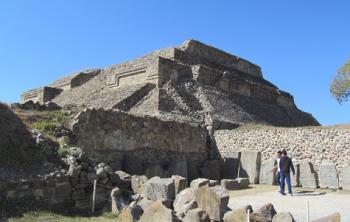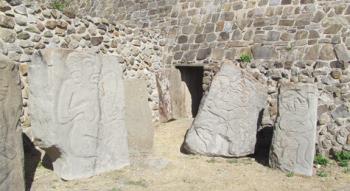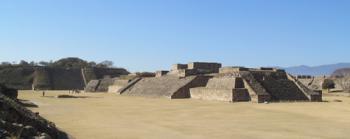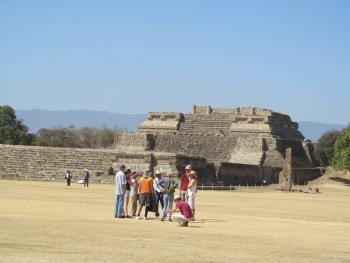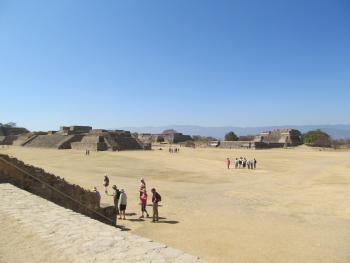Monte Albán, city of the cloud people
This item appears on page 44 of the November 2019 issue.
In the valleys 290 miles southeast of Mexico City, one of Mesoamerica’s earliest civilizations, the Zapotecs, developed. Living off the land, hunter-gatherers first appeared in these valleys about 10,000 years ago. By about 5000-4000 BC, these early settlers had begun to cultivate the land. The first important settlement identifiable as Zapotec, San José Mogote, can be dated to between 1450 and 1150 BC. By the 8th to 7th centuries BC, this settlement had expanded to include dozens of smaller valley settlements.
As San José Mogote eventually declined in importance, another Zapotec settlement — Monte Albán — rose to take its place after about 500 BC. Monte Albán grew to become the most powerful city in the Oaxaca valleys, reaching its apogee from AD 200 to 750, with a population estimated between 20,000 and 35,000.
The archaeological site of Monte Albán is among the most important in Mexico, a country rich in pre-Hispanic sites. Located 7 miles west of the city of Oaxaca, it’s also among the most spectacular, perched on a leveled-off hilltop high above the valley floor.
Aztec merchants gave the people of Monte Albán the name Tzapotecatl. Early Spaniards transformed this into the word “Zapotec.” But the people called themselves “be’ena za’a,” cloud people. An appropriate name, I thought, as I stood at the top of a stone stairway at Monte Albán overlooking the archaeological complex.
I love doing what Australians call a walkabout, although in my case it’s not an adventurous wandering through the Outback but more of a leisurely stroll around an archaeological site, absorbing the “feel” of the site, identifying some of the most important structures and reading a little about each one.
The leisurely stroll is especially important at Monte Albán because it is such a large site dotted with so many noteworthy buildings. One could spend days exploring. But on a day visit, a slow walkabout had to suffice for me.
There is no better place to begin than at the top of the staircase overlooking the immense Grand Plaza, which was the center of civic and ceremonial life at Monte Albán for over 1,200 years.
To the left is the I-shaped Ball Court, with steep, stepped sides on either side of a central court. Down the stairs to the right looms the huge North Platform, with a wide staircase leading up to a dozen column bases that once supported a roofed portico. Beyond a sunken patio are buildings that were part of a ceremonial complex.
Walking counterclockwise past the North Platform, visitors come to Building K, consisting of two patios leading to a staircase up to a temple. On the north side stands a 17-foot-high stela fragment with glyphs carved into the stone.
Danzantes
Adjacent to Building K is arguably Monte Albán’s most famous site, Building L, an early structure dating from the Monte Albán I period, with a later structure superimposed on top of it.
It’s famous for the figures, called Danzantes (Dancers), carved on stone slabs. They are figures of men who seem to be moving about jerkily, as if dancing. Far from dancing, however, they are probably vanquished captive warriors who are about to be sacrificed or who have already been sacrificed.
Visitors can walk inside Building L between the inner and outer pyramids to see more Danzantes figures.
Opposite the Danzantes are the central mounds in the plaza labeled G, H and I, three structures lined up shoulder to shoulder, each with its own temple.
Observatory
At the south end of these mounds is yet another Monte Albán highlight. Called Building J, or the Observatory, it stands at a 45-degree angle to the other Grand Plaza structures. Archaeologists believe it was used to track the seasons through observing the sky, hence its name: the Observatory.
There are “conquest stones” lying along the outer walls, probably symbolizing places and peoples conquered by Monte Albán.
Walking back along the east side of the Grand Plaza takes visitors past more temples and palaces to the staircase just below the Ball Court where our walkabout began.
Tomb 7
There are numerous tombs, most closed, dotting the area around the Grand Plaza complex. The best known, located close to the on-site museum, is Tomb 7, discovered in 1932. Originally a Zapotec tomb, it was reused by the Mixtecs, who probably arrived in the Oaxaca area in the 9th and 10th centuries AD.
In this tomb, the Mixtecs buried a high-ranking official together with a trove of gold, silver, jade, turquoise, amber, pearl, coral and alabaster objects. You won’t find any of these in Tomb 7 any longer. They are now on display in the Museum of Oaxacan Cultures, in what was once the monastery adjoining the Church of Santo Domingo, in Oaxaca.
The on-site museum displays the originals of the Danzantes, the “conquest stones” and a number of stelae. Look for the stela with bars and dots, an early example of the Mesoamerican numeric system.
Mixtec Mitla
No trip to Oaxaca would be complete without a visit to Mitla, the second-most-important archaeological site in the Oaxaca area. Located 28 miles southeast of the city of Oaxaca, Mitla’s origins are Zapotec, but while Monte Albán was the political and ceremonial center for the Zapotecs, Mitla may have been its religious center.
The architectural touches that make Mitla unique — the intricate fretwork of geometric patterns that covers panels and walls of buildings — are “classic Zapotec.” It is speculated the fretwork may symbolize the sky serpent, Quetzalcóatl. Frescoes and some tile work may have been added by the Mixtecs when they arrived in the Oaxaca valleys.
The two complexes to visit at Mitla are the Church Group and the Columns Group. A colonial-era church, built of stones taken from the Church Group, occupies much of the first of the three patios comprising the Church Group. The Columns Group too consists of three patios with surrounding rooms. The central stairway leads into a 120-foot-long room with six huge columns that give this group of buildings its name.
To the Zapotecs, we owe awe-inspiring, monumental Monte Albán. To the Mixtecs, the decorations adorning the walls at Mitla. An unbeatable duo.
If you go…
It’s easy to reach both Monte Albán and Mitla by taxi or car service from Oaxaca. There are group tours to both sites, but the pace does not allow for much lingering to enjoy and absorb what you’re seeing. If going on your own, allow at least three to four hours for Monte Albán and at least two hours for Mitla. It’s best not to combine both of these fabulous sites into one day.
The entrance fee at Monte Albán is 75 pesos, about $3.75. Hours are 8 to 4:30 daily. The entrance fee at Mitla is 65 pesos, $3.25, and it’s open 8 to 5 daily.
Oaxaca is a “foodie” paradise. Although my husband and I dined at a wide range of venues, ranging from the cafés ringing the Zócalo, Oaxaca’s central plaza, to upscale and expensive Criollo, our favorite was the restaurant at the Quinta Real Hotel, where, in patios overflowing with greenery and flowers, we dined five times during our 14 nights in Oaxaca.
Through Vrbo (vrbo.com), we rented a comfortable new home (4500438) in the quiet neighborhood of Jalatlaco, about a 10- to 15-minute taxi ride from the Zócalo. It had a large living/dining room, a kitchen, an office, three bedrooms, two-and-a-half bathrooms, a small interior patio and a huge roof terrace.
We thought the price was a bargain for what we got: $95 per night. The only thing the house lacked was a washing machine, but an inexpensive same-day laundry service was a 5-minute walk away.

